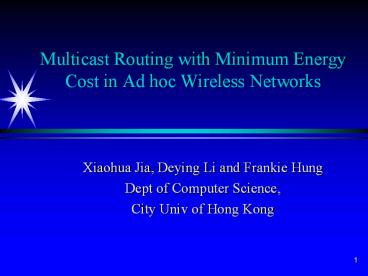Multicast%20Routing%20with%20Minimum%20Energy%20Cost%20in%20Ad%20hoc%20Wireless%20Networks - PowerPoint PPT Presentation
Title:
Multicast%20Routing%20with%20Minimum%20Energy%20Cost%20in%20Ad%20hoc%20Wireless%20Networks
Description:
Orphan: a subtree whose root is not s. O: the set of orphans. ... link v to the roots of the orphans by shortest paths; 11. Simulation Results. N=50, R=0.2 ... – PowerPoint PPT presentation
Number of Views:80
Avg rating:3.0/5.0
Title: Multicast%20Routing%20with%20Minimum%20Energy%20Cost%20in%20Ad%20hoc%20Wireless%20Networks
1
Multicast Routing with Minimum Energy Cost in Ad
hoc Wireless Networks
- Xiaohua Jia, Deying Li and Frankie Hung
- Dept of Computer Science,
- City Univ of Hong Kong
2
Energy-efficiency in ad hoc networks
- Power function
- p(u,v) da(u,v), 2 a 4
- Two special features of radio transmission
- Broadcast in nature.
- p(u,w) p(w,v) lt p(u,v),
- relaying messages by a third node may result in
a smaller energy cost.
3
Multicast Routing with Min Energy Cost
- Problem Given a directed network graph G(V,A),
and a multicast request (s, D), each node v has
a given transmission power p(v), find a multicast
tree T rooted at s and covering all nodes in D,
such that - where NL(T) is the set of non-leaf nodes of T.
4
Related Work
BIP / MIP (Multicast Incremental Power) BIP is
based on Prims MST algorithm. Starting from s,
each time a node with least incremental power is
added to the tree, until all nodes are in the
tree. MIP tree is obtained by pruning the BIP
tree. J.E. Wieselthier, G. D. Nguyen, and A.
Ephremides, On the Construction of
Energy-Efficient Broadcast and Multicast Trees in
Wireless Networks, IEEE Infocom00.
s
5
Related Wrok (Contd)
- Deying Li, Xiaohua Jia and Hai Liu, Energy
Efficient Broadcast Routing in Ad Hoc Wireless
Networks, IEEE Trans. On Mobile Computing ,
vol.3, no.2, 2004. - An approximation algorithm based on node-weighted
Steiner tree method was proposed and the
approximation ratio is 2ln(n-1)1.
6
Theoretical Results
The energy efficient multicast routing problem is
NP-Hard and there is NO constant approximation
ratio.
7
Heuristic A. Transforming the problem to the
Steiner tree problem
- The multicast routing problem is transformed to
finding a directed tree T in G that covers all
nodes in D and the total weights of T (edge
weights) is minimized.
8
Heuristic B. Node-join-Tree method
- Vi set of outgoing neighbors of node i
- C s // C covered set
- U D - Vs // U uncovered set
- X Vs // X candidate set for covering nodes
- While (U ?? ) do
- choose vi ? (X C) with max(VinU/p(i))
- C C? vi U (U Vi) X X? Vi
9
Heuristic C. Tree-join-Tree method
- The basic idea is
- Initially, each node in D is a subtree.
- Find a node v ? V that uses the least amount of
energy to link the roots of at least two subtrees
and merge them into a bigger one (v becomes the
root of the new subtree). - Repeat (2) until all subtrees form into a single
tree rooted at s.
10
Heuristic C. Tree-join-Tree method (contd)
- Orphan a subtree whose root is not s.
- O the set of orphans.
- min-quotient-cost(v) MinS ? O
TreeCost(v,S)/S for S ? O. - O i i? D)
- While (O ?? ) do
- choose v ? V with Min min-quotient-cost(v)
- link v to the roots of the orphans by shortest
paths
11
Simulation Results
N50, R0.2
Energy cost vs. multicast group size
12
Simulation Results (Contd)
M10, R0.2
Energy cost vs. network size
13
Simulation Results (Contd)
M10, R
Energy cost vs. network size
14
Simulation Results (Contd)
M10, N50
Energy cost vs. transmission range
15
Conclusions
- Investigated energy efficient multicast routing
problem. - Three heuristic methods, Steiner tree based,
node-join-tree, and tree-join-tree, were
proposed. - The node-join-tree method can be extended to a
distributed version. It uses only the neighbour
information to construct the multicast tree. - Simulation results suggested the simple
node-join-tree method performs the best among the
other methods.































